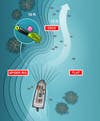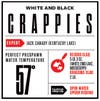Crappie Fishing: How to Catch Prespawn Slabs
Photo by Michelle Brantley If nothing fires you up like a bug-eyed, plate-size freak of a panfish, then you need...

Photo by Michelle Brantley
If nothing fires you up like a bug-eyed, plate-size freak of a panfish, then you need to be on the water now—and try these prespawn trophy-slab tactics.
As fishing goes, it doesn’t get much easier than filling a bucket with summertime sunnies. But to stack up honest-to-goodness slab panfish—titty bream, elephant perch, and the like—now is the time.
Warm spring days bring your favorite fishing holes to life with tiny baitfish, insects, crustaceans—and the big panfish that love to eat them. Crappies, bluegills, and yellow perch gorge themselves just ahead of the spawn, and like a prison chow line, the big ones eat first.
We found three local-legend panfish fanatics who own the prespawn. These are the guys the church calls each spring for the big fish fry. They can smell a bream bed from 50 yards and feel a crappie bite in their sleep. And they can show you how to catch more slabs right now.

Illustration by Ryan Kirby
Sweep the creek
Kentucky lake guide Jack Canady (270-227-2443) spider-rigs the edges of major creek arms bordering shallow spawning flats this time of year. A trip that doesn’t yield a couple of 2-pounders is unusual, he says. On some of his favorite lakes in Mississippi, 3-pounders are common.
“Prespawn fish treat these creek drops like a road intersection. They concentrate there in huge numbers, waiting for warmer water temps before moving shallower to begin spawning,” Canady says.
He starts by following the creek contours with side-scan sonar early in the morning, looking for staging fish. “They’re usually suspended in about 12 feet of water,” he says. “But the biting fish may be only 5 feet down. It’s better to fish too shallow at first, because crappies will come up to hit a jig but never down.”

Canady spreads eight 12-foot rods in holders across the bow of his boat. Each is spooled with 6- to 8-pound mono. He clamps a 3⁄8-ounce split shot 18 inches above a 1⁄16-ounce jig-and-tube combo secured to the line with a loop knot and tipped with a Berkley PowerBait Crappie Nibble. “The lines must stay vertical,” he stresses. “If they’re swinging back under the boat, you need to increase the sinker size or slow down.”
Canady changes jig body colors all day. “The biggest fish will lock onto one color for a while and then switch.” They’ll frequently favor one side of the spread over the other, too, which can tip you off to where they’re holding in relation to the creek. “As the sun gets up, the fish will often leave the creeks and scatter on the flats. You just keep moving until you find them again.”